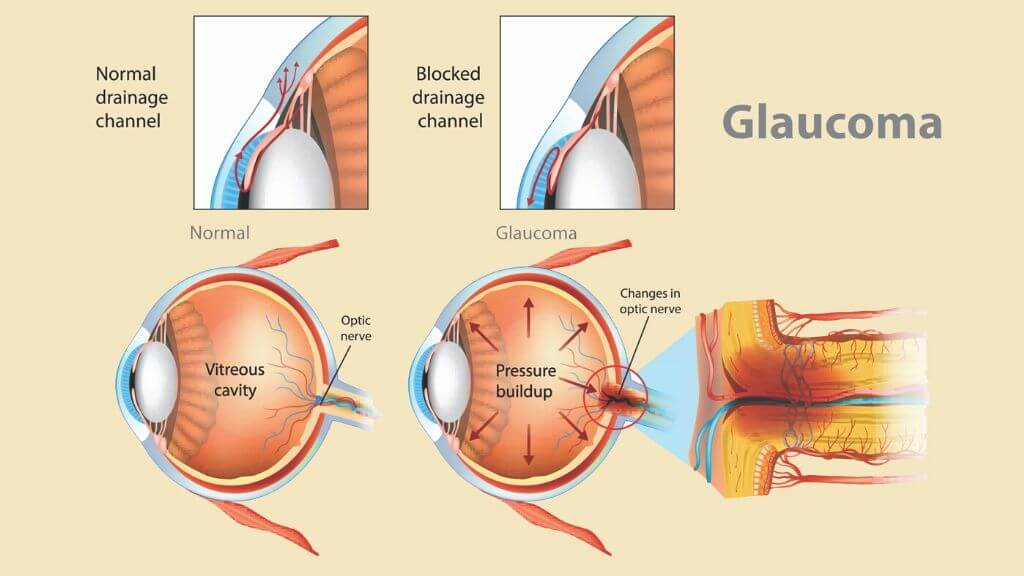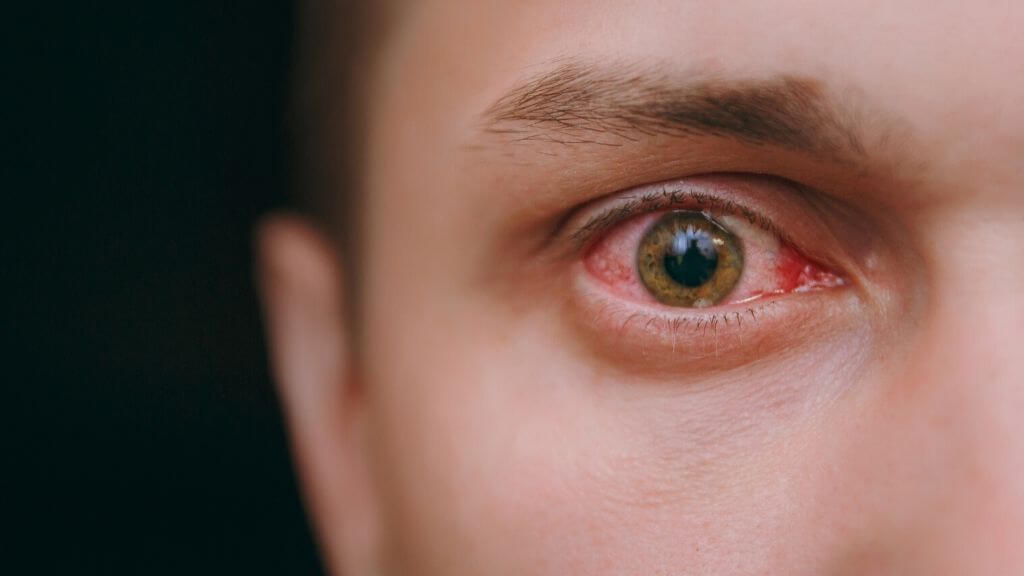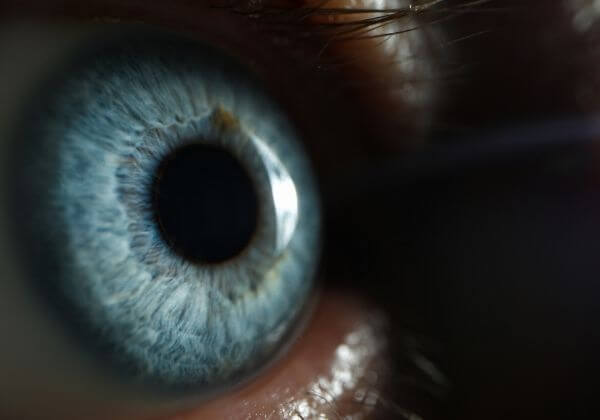Glaucoma is a collection of eye disease that causes damage to the optic nerve. The optic nerve is an essential element of good vision. It supplies visual information from the eye to the brain.
Glaucoma is typically the result of long term pressure inside the eye. The optic nerve tissue becomes eroded under this high-pressure, resulting in blindness. With early intervention, you can prevent further vision loss.
What Causes Glaucoma?
The back of the eye produces a fluid known as aqueous humor. This clear fluid fills the front of the eye and leaves through the iris and cornea. If the channels this fluid needs to leave through become blocked, pressure develops in the eye. As this intraocular pressure increases, the optic nerve can become damaged. As this damage worsens, you begin to lose vision.
The specific cause for this increased pressure is unknown, but physicians believe several factors can play a role.
♦ Medications like corticosteroids
♦ Reduced blood flow to the optic nerve
♦ High blood pressure
♦ Dilating eye drops

What Are the Variations of Glaucoma?
There are five major types of glaucoma.
♦ Open-Angle Glaucoma (Chronic): This is the most common type. There are no signs and symptoms except for the gradual loss of vision. In many cases, vision deterioration is so slow that irreversible damage is done before individuals notice any other signs. Other signs become apparent.
♦ Angle-Closure Glaucoma (Acute): When the aqueous humor is suddenly blocked, the rapid buildup of fluid causes a more severe reaction. There is a quick and severe increase in pressure that is very painful. This type of glaucoma is considered a medical emergency. You need to seek medical attention if you notice severe pain and nausea along with a blurred vision.
♦ Congenital Glaucoma: Congenital glaucoma can run in families. When you are born with congenital glaucoma, there is a defect in the angle of the eye. This slows the normal drainage of fluid from the eye. Symptoms include excessive tears, cloudy eyes, and sensitivity to light.
♦ Secondary Glaucoma: This is typically a side effect of an injury or another eye condition. Cataracts and eye tumors are commonly known to cause glaucoma. In very rare cases, surgery can cause secondary glaucoma. Corticosteroids can help this condition and are the most common treatment option.
♦ Normal-Tension Glaucoma: People without increased eye pressure can develop glaucoma, and there is no known cause. Extreme sensitivity or reduced blood flow to the optic nerve are factors associated with this type of glaucoma.
Glaucoma Symptoms
The symptoms of glaucoma vary depending on the type and stage of the condition. The most common type of glaucoma (chronic) does not have any symptoms other than gradual vision loss.

Getting comprehensive eye exams each year is important in detecting any vision loss early. Acute glaucoma presents with identifiable symptoms. It is a medical emergency so seek medical attention if you notice any of the following:
♦ Severe eye pain
♦ Nausea or vomiting
♦ Redness in the eye
♦ Sudden disturbances in vision
♦ Sudden blurred vision
♦ Seeing colored rings around lights
Glaucoma Diagnosis
An ophthalmologist needs to diagnose glaucoma. They will perform a comprehensive eye exam to check for signs of deterioration. They also need to check for any nerve tissue loss.
A detailed medical history is needed to determine if there is a family history of glaucoma. It is also important to discover if there are any other conditions that may impact eye health. Several tests are used to help ophthalmologists make a glaucoma diagnosis.
♦ A tonometry test is used to measure the internal pressure within your eye.
♦ Perimetry test, or visual field test, is used to determine if the glaucoma is affecting your field of vision. Your peripheral and central vision is tested.
♦ Pachymetry test is used to determine if you have thinner corneas than normal. Individuals with thin corneas are more at risk for glaucoma.
Treatment for Glaucoma
The goal of treatment is to reduce the intraocular pressure. Treatment is also designed to reduce any further vision deterioration. Prescription eye drops are the first step. If these do not work, then more advanced treatment is required.
Medications are available to reduce intraocular pressure, and a combination of these may be prescribed. In some cases, a blocked channel can be corrected with surgery. A drainage path is made for fluid, or tissues causing the fluid buildup can be surgically removed.
Angle-closure glaucoma is treated differently, as it is a medical emergency. Immediate medical attention is needed to reduce rapid fluid accumulation. If medications do not work, then reversing the angle-closure is attempted. If this is unsuccessful, a laser procedure is used. A peripheral iridotomy creates small holes in the iris to accommodate the increase in fluid movement.

Glaucoma Diet
There is not a diet that can cure glaucoma, but the right foods can help with eye healing and slowing the progression of the disease. The best diet for glaucoma will consist of fresh fruits and vegetables, whole grains, seeds, and nuts. Carrots and dark leafy vegetables are the best.
Once diagnosed, you want to avoid caffeine as this can increase blood pressure and intraocular pressure, but a great alternative is green tea. The powerful antioxidants can protect the optic nerve from serious damage.
Natural Treatments for Glaucoma
There is no prevention or cure for glaucoma, but in addition to medical treatment, there are things you can do to naturally protect your eyes.
♦ Vegetable juice: A combination of carrots and spinach on a regular basis provides essential eye nutrients. The two juices together can reduce eye pressure and nourish the eye. This can slow the progression of glaucoma and deliver relief from any symptoms.
♦ Cayenne pepper: It may not seem like a spicy compound is beneficial for eyes, but cayenne pepper can help. The powerful anti-inflammatory compounds can help open eye blockages. This is best used in small quantities as an eyewash, with lots of water.
♦ Fennel: Fennel is one of the greatest natural treatments for glaucoma. Chewing a handful of seeds during the day brings quick relief of glaucoma symptoms. You can also add the seeds to boiling water and drink the fennel tea during the day.
Glaucoma Statistics
♦ Glaucoma is the most common cause of irreversible blindness.
♦ Half of those with glaucoma are unaware they are affected.
♦ An estimated 79.6 million are expected to have glaucoma in 2020.
♦ More than 11 million individuals will go blind as a result of glaucoma.

Glaucoma and Surgery
Non-surgical treatment options are tried first. In some cases, surgery may be required to reduce intraocular pressure. Several surgical methods can be used for treating glaucoma.
♦ Canaloplasty: This does not penetrate the eye, as it releases fluid using microcatheter technology.
♦ Trabeculectomy: This is a conventional surgical procedure to drain the fluid.
Glaucoma drainage implant surgery: A flow tube is inserted in the anterior chamber of the eye. A plate is implanted under the conjunctiva to allow the fluid to flow.
♦ Laser-assisted non-penetrating deep sclerectomy: This is the most commonly used treatment for glaucoma today. It is similar to a trabeculectomy but without the penetration of the sclera.
Glaucoma and Children
It is possible that glaucoma can be present from birth. It can also develop during the first few years of life. In these cases, the optic nerve has likely been damaged by an underlying medical condition.
Glaucoma can run in families, so children with the condition in their family are more likely to develop this early. Children with glaucoma will have enlarged eyes, a cloudy cornea, and sensitivity to light. Children with glaucoma can live normal lives with effective management. Early diagnosis is essential to reducing vision loss in children.
What Is the Long-Term Outlook?
Glaucoma cannot be prevented, but when caught early, treatment can minimize vision loss. Without treatment, glaucoma can cause blindness, so you need to identify it before it worsens. Annual preventative eye exams are the best way to catch glaucoma early.
Routine eye exams and promoting eye health are the best way to reduce the risks of glaucoma. Even with glaucoma, treatment allows you to live a normal life.






